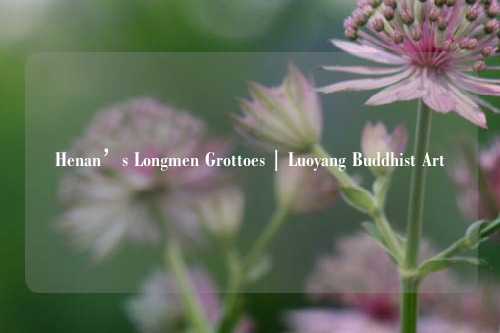Henan’s Longmen Grottoes | Luoyang Buddhist Art
The Splendor of Henan’s Longmen Grottoes
Nestled in the heart of Luoyang, Henan Province, the Longmen Grottoes stand as one of China’s most significant and awe-inspiring cultural landmarks. Carved into the cliffs along the Yi River, this collection of caves and statues showcases an impressive artistic achievement, with over 100,000 Buddhist statues, carvings, and inscriptions dating back over 1,500 years. The Longmen Grottoes offer visitors a glimpse into the spiritual and artistic achievements of ancient China, as well as a deep connection to the country’s religious history. Whether you're an art enthusiast, a history buff, or simply someone interested in exploring China’s cultural heritage, the Longmen Grottoes provide an unforgettable experience.
A History Etched in Stone
The creation of the Longmen Grottoes began during the Northern Wei Dynasty (386–534 AD) and continued through the Tang Dynasty (618–907 AD), making it one of the most extensive collections of Buddhist rock art in the world. The site, which stretches for over a kilometer along the cliffs of the Yi River, was developed over several centuries and reflects the evolving nature of Chinese Buddhism during this period.

The grottoes were commissioned by emperors and wealthy individuals, who believed that the act of constructing these intricate sculptures would not only bring religious merit but also demonstrate their devotion to Buddhism. Over the centuries, thousands of artisans worked tirelessly to carve these masterpieces, which were not only religious symbols but also artistic representations of the cultural and societal changes of the time.
The Magnificent Statues and Carvings
The Longmen Grottoes are home to an extensive collection of Buddhist statues, ranging from tiny carvings to colossal figures. The most iconic of these is the Vairocana Buddha, a monumental figure standing at over 17 meters tall. The Vairocana Buddha, housed in the Fengxian Temple, is one of the most remarkable sculptures in the grottoes and serves as a symbol of the spiritual power and artistic prowess of the time.
In addition to the Vairocana Buddha, the site is home to thousands of smaller statues, each with unique features and expressions. Some statues represent Buddha, while others depict bodhisattvas, disciples, and guardians. These figures are not just decorative; they also offer valuable insight into the religious and cultural ideals of ancient China. The fine details of the carvings, from the folds of robes to the serene expressions on the faces of the statues, reveal a level of craftsmanship and devotion that is truly remarkable.
Architectural Marvels: The Caves and Temples
The Longmen Grottoes are not just a collection of statues; the caves and temples themselves are architectural masterpieces. These caves were carved directly into the limestone cliffs, with each grotto varying in size and design. Some caves were designed as small shrines, while others are large temples with intricate carvings and multiple statues.
One of the most impressive temples within the grottoes is the Fengxian Temple, which houses the towering Vairocana Buddha. The temple’s design is symmetrical, with large pillars supporting a roof that is adorned with intricate carvings of Buddhist deities and symbols. The architecture of the caves and temples provides an excellent example of the fusion of Buddhist, Taoist, and Chinese artistic traditions.
The Binyang Caves, another important section of the grottoes, feature impressive examples of Buddhist architecture, including some of the oldest statues at the site. These caves offer a glimpse into the early stages of the development of Buddhist rock art in China.
A Symbol of Religious Devotion
The Longmen Grottoes are more than just an artistic treasure trove; they are also a symbol of China’s deep religious devotion. The majority of the statues and carvings depict scenes from Buddhist teachings, including the life of the Buddha, his enlightenment, and the Buddhist path to Nirvana. The vast number of statues reflects the importance of Buddhism in Chinese society during the time the grottoes were constructed.
Many of the statues also feature inscriptions that provide a wealth of historical and religious information. These inscriptions often detail the names of the patrons who commissioned the works, the date of their creation, and their religious significance. Some of these inscriptions are written in ancient Chinese characters, making the site an important resource for scholars studying the development of Chinese script.
The Cultural Significance of the Longmen Grottoes
The Longmen Grottoes hold immense cultural significance not just for China, but for the entire world. As one of the three major Buddhist rock-cut art sites in China (along with the Mogao Caves in Dunhuang and the Yungang Grottoes in Shanxi), the Longmen Grottoes represent the zenith of Buddhist rock art in China. They serve as a testament to the enduring power of religious art and its ability to reflect the spiritual and philosophical ideals of a society.
The grottoes also offer a glimpse into the technological advancements of ancient China. The construction of the caves and statues required not only artistic skill but also engineering expertise. The site is a reflection of the sophisticated techniques used by artisans of the time, including the ability to carve intricate figures from the solid rock of the cliffs.
Visiting the Longmen Grottoes
A visit to the Longmen Grottoes is a journey back in time, offering a rare chance to experience one of China’s greatest cultural and artistic treasures. The site is divided into several main sections, each with its own unique features. Visitors can explore the Northern Section, which is home to some of the earliest statues, as well as the Southern Section, which houses later and larger statues, including the magnificent Vairocana Buddha.
The Xiangshan Temple, located on the opposite side of the river, offers stunning views of the grottoes and is a perfect spot for taking in the site’s full grandeur. A walk along the cliffs will allow visitors to appreciate the scale and beauty of the carvings from different angles, as the statues are strategically placed in caves and niches along the rugged landscape.
To help visitors understand the historical and cultural significance of the site, there are informative signs and guides available throughout the grottoes. Visitors can also take part in guided tours that provide deeper insights into the artistry, history, and religious aspects of the site.
Preservation and Conservation Efforts
Over the years, the Longmen Grottoes have faced challenges from natural weathering, pollution, and human activity. To preserve this invaluable cultural site for future generations, ongoing conservation efforts have been undertaken. The Chinese government, along with international organizations, has invested in the restoration and protection of the grottoes, employing advanced technologies and methods to safeguard the delicate carvings and statues from further damage.
The Longmen Grottoes were designated a UNESCO World Heritage Site in 2000, a recognition that has helped to raise awareness of the need for preservation. The site’s status as a UNESCO World Heritage Site also means that it is protected under international law, ensuring its long-term conservation and preventing any irreversible damage from taking place.
The Longmen Grottoes Today
Today, the Longmen Grottoes continue to be a major tourist destination, attracting visitors from around the world. The site’s combination of natural beauty, historical significance, and artistic achievement makes it a must-visit location for anyone interested in China’s rich cultural heritage.
For those visiting Luoyang, the Longmen Grottoes offer a chance to experience one of the finest examples of ancient Chinese art and architecture. The site remains an enduring testament to the religious devotion, artistic skill, and cultural achievements of ancient China. It is a place where the past comes to life, inviting visitors to explore the beauty and history of this extraordinary location.
















